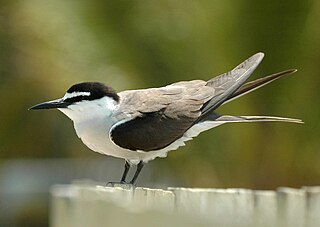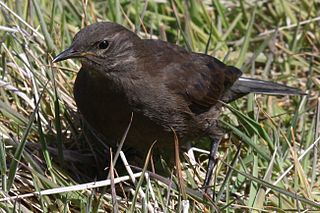
The chinstrap penguin is a species of penguin that inhabits a variety of islands and shores in the Southern Pacific and the Antarctic Oceans. Its name stems from the narrow black band under its head, which makes it appear as if it were wearing a black helmet, making it easy to identify. Other common names include ringed penguin, bearded penguin, and stonecracker penguin, due to its loud, harsh call.

The bridled tern is a seabird of the family Laridae. It is a bird of the tropical oceans. The scientific name is from Ancient Greek. The genus comes from onux meaning "claw" or "nail", and prion, meaning "saw". The specific anaethetus means "senseless, stupid".

The gummy shark, also known as the Australian smooth hound, flake, sweet william or smooth dog-shark, is a shark in the family Triakidae. These small to medium-sized bottom-dwelling sharks are found mostly in, but are not limited to, the area around the southern seas of Australia and is commonly baited and fished for cuisine because of its taste and market prices.

Palaeeudyptes antarcticus, also referred to as the narrow-flippered penguin, is the type species of the extinct penguin genus Palaeeudyptes. It was a huge species, albeit probably with a large size variation. Although the size range can only be loosely estimated, the birds seem to have stood between 43 and 55 inches high in life, placing this species and its congener Palaeeudyptes marplesi among the largest penguin species known. It was the last known Palaeeudyptes species, and although the exact time when it lived is not precisely determined, it may have evolved from P. marplesi, or they might even have been a single species which slightly decreased in size over time.

Somniosus is a widely distributed genus of deepwater dogfish sharks in the family Somniosidae. Several members of the genus are believed to attain lengths up to 7 m (23 ft), thus ranking among the largest of sharks.

The blackish cinclodes is a passerine bird of the genus Cinclodes belonging to the ovenbird family Furnariidae. It is native to the southern tip of South America including the Falkland Islands where it is known as the tussac-bird or tussock-bird. It is often very tame and will approach humans closely.

The austral rail is a species of bird in the family Rallidae. It is found in Argentina and Chile. Its natural habitats are swamps, freshwater lakes, and freshwater marshes. It is threatened by habitat loss caused by the development of intensive agriculture.

The southern sleeper shark or Whitley's sleeper shark is a deepwater benthopelagic sleeper shark of the family Somniosidae found in the southern Atlantic, Indian, and Pacific Oceans. It is known from depths of 400 to 1,100 m. Its length is up to 4.4 m (14 ft). It feeds primarily on cephalopods, especially squid and fish; its stomach contents also less commonly contain remains of marine mammals and birds. Based on its generally sluggish nature and the speed of its prey, it is thought to be an ambush predator. A 3.6 m (12 ft) long female caught off the coast of Chile had a whole southern right whale dolphin in its stomach. This dogfish is sometimes taken as bycatch in the orange roughy and Patagonian toothfish fisheries; whether this poses a threat to the species is currently unknown.
Alaskozetes antarcticus is a species of non-parasitic mite, known for its ability to survive in subzero temperatures.
Antarctica is one of the most physically and chemically extreme terrestrial environments to be inhabited by lifeforms. The largest plants are mosses, and the largest animals that do not leave the continent are a few species of insects.
Hydrogamasellus is a genus of mites in the family Ologamasidae.
Hydrogamasellus brevispiritus is a species of mite in the family Ologamasidae.
Hydrogamasellus calculus is a species of mite in the family Ologamasidae.
Hydrogamasellus contingentis is a species of mite in the family Ologamasidae.
Hydrogamasellus stipulae is a species of mite in the family Ologamasidae.
Ophiclinus antarcticus, the Adelaide snake blenny, is a species of clinid found in the coastal waters of southern Australia. It can reach a maximum length of 14 centimetres (5.5 in) TL. It often has dark blotches and speckles on its body and fins, with a series of large white blotches along the midside, dorsal-fin base and just above the anal-fin base. It also has several dark stripes that often radiate from its eyes and dark brown markings on the lips and lower side of the head.

Glyptonotus antarcticus is a benthic marine isopod crustacean in the suborder Valvifera. This relatively large isopod is found in the Southern Ocean around Antarctica. It was first described by James Eights in 1852 and the type locality is the South Shetland Islands.
This article lists the various snakes of Australia which live in a wide variety of habitats around the country. The amethystine python or scrub python is considered Australia's largest native snake.
Cryomyces antarcticus is a fungus of uncertain placement in the class Dothideomycetes, division Ascomycota. Found in Antarctica, it was described as new to science in 2005. It has been found to be able to survive the harsh outer space environment and cosmic radiation. A proposed mechanistic contributor to the unique resilience observed in C. antarcticus is the presence of its thick and highly melanized cell walls. This melanin may act to protect DNA from damage while C. antarcticus is exposed to conditions that are unsuitable for typical DNA repair systems to function.

Imperobator is a genus of paravian theropod that lived during the Maastrichtian stage of the Late Cretaceous period in what is now Antarctica. It contains a single species, I. antarcticus, recovered from the Snow Hill Island Formation. Before its description, it was informally nicknamed the "Naze dromaeosaur", despite the lack of a "sickle claw" characteristic of the group. In 2019, the describing authors suggested that Imperobator was about the same size as Utahraptor.









